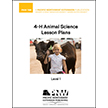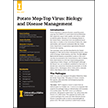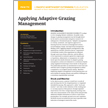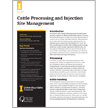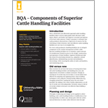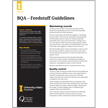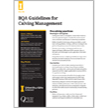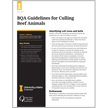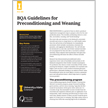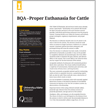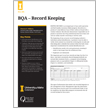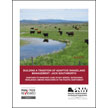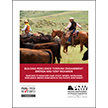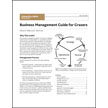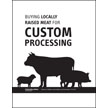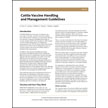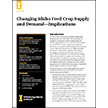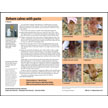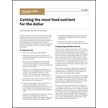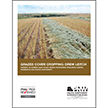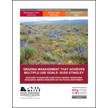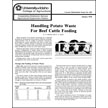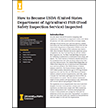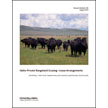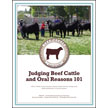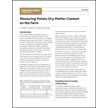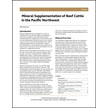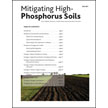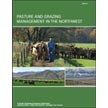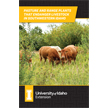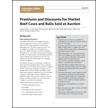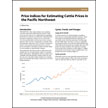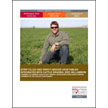Beef Cattle
4-H Animal Science Lesson Plans: Level 1
By providing instruction outlines for adults, this 263-page curriculum delivers animal science education to youth, particularly 4-H members working with beef, sheep, swine and goats. The 38...
Answers to Common Questions about Greenhouse Gases
Because climate change is one of the most urgent issues of our time, meaningful public discourse about it requires a basic understanding of the types of greenhouse gases (GHGs) involved, where they...
Applying Adaptive Grazing Management
Grazing management requires flexibility to adapt to ever-changing climatic conditions, and changes in grazing management for public lands may be required because of endangered or threatened species.
BQA: Cattle Processing and Injection Site Management
Successful beef producers know that beef quality assurance requires keeping cattle healthy throughout their lives. Since cattle can get sick, preventing and treating disease means processing cattle...
BQA: Components of Superior Cattle Handling Facilities
Well-designed and effectively run cattle-handling facilities help to decrease cattle injury, illness and death; ensure high-quality beef; and improve consumer perceptions of the beef cattle industry.
Beef producers must document the safety of their product by keeping accurate records of the feedstuffs they use in their operations, including records of pesticides being applied to feed crops.
BQA: Guidelines for Calving Management
Good calving management practices can increase animal health and beef product safety by reducing the need for antibiotics and other pharmaceutical treatments. This publication discusses numerous...
BQA: Guidelines for Culling Beef Animals
Having a plan for identifying cull animals is key for maintaining a safe and healthy cow herd. This publication explains how to identify animals that should be removed from the herd, when to cull...
BQA: Guidelines for Preconditioning and Weaning
Preconditioning calves involves a number of practices that prepare calves for the next production phase and includes acclimating calves to a new diet, vaccinating and weaning calves, and teaching...
BQA: Proper Euthanasia for Cattle
Termination of an animal's life should be taken seriously and done in the most humane manner possible. This brief publication discusses making euthanasia decisions, methods of proper euthanasia and...
Keeping accurate records on a consistent basis is important for maintaining beef quality assurance and a healthy herd, and to protect a beef operation from litigation regarding drug residue. This...
This publication is part of the Rancher-to-Rancher Case Study Series: Increasing resilience among ranchers in the Pacific Northwest. Authors: Sonia A. Hall, Tipton D. Hudson, Georgine G. Yorgey, J.
This publication is part of the Rancher-to-Rancher Case Study Series: Increasing resilience among ranchers in the Pacific Northwest. Authors: Sonia A. Hall, Tipton D. Hudson, K. Scott Jensen, J.
Business Management Guide for Grazers
Describes the management process for management-intensive grazing (MiG) as a series of three recurring operations: strategic, tactical and operational. Provides sample enterprise budgets and...
Buying Locally Raised Meat for Custom Processing
Most people who buy meat from a local producer purchase a live animal (or a portion of one) and have it butchered by a "custom-exempt" processing plant. This publication explains how the process...
Cattle Vaccine Handling and Management Guidelines
Recent research indicates vaccine efficacy is at risk due to improper handling and storage by retailers and livestock producers. Following these guidelines will help ensure effective disease...
Changing Idaho Feed Crop Supply and Demand—Implications
The number of animals in concentrated animal feeding operations has increased since the early 1990s. The upsurge has influenced the supply and demand for crops used as feed, like alfalfa hay,...
Country of Origin Labeling and Livestock Producers
The COOL (country of origin labeling) law is federal regulation that requires any person or entity that supplies a COOL covered commodity to food retailers, such as supermarkets, club warehouses,...
Dehorn Calves with Paste/Descornar Terneras con Pasta
Of the various methods for dehorning calves that will live in confined areas, dehorning with paste is easy, effective, economical and low stress to the animals. This illustrated sheet covers the...
Getting Ready for the Fair: Clipping Beef Cattle
Clipping a steer not only helps the animal regulate its temperature more efficiently, it improves its appearance for showtime or auction. But it’s a learned skill that takes a lot of practice. This...
Getting the Most Feed Nutrient for the Dollar
This publication describes a process livestock producers should use to determine the value of a feed that will provide energy or protein to balance a forage-based ration. Authors: Glenn Shewmaker,...
Grazed Cover Cropping, Drew Leitch (Farmer to Farmer Case Study Series)
An Inland Northwest farmer has been trialing spring and fall-seeded cover cropping for cow-calf grazing and the effects on the following grain crops. Authors: Georgine Yorgey, Kristy Borrelli,...
This publication is part of the Rancher-to-Rancher Case Study Series: Increasing resilience among ranchers in the Pacific Northwest. Authors: Tipton D. Hudson, Sonia A. Hall, J. Shannon Neibergs,...
Handling Potato Waste for Beef Cattle Feeding
Feeding potato waste to beef cattle requires good feed management and certain precautions. This publication covers the storage and feeding of different forms of potato waste including filter cake...
Selling meat products successfully involves complying with regulations, particularly surviving a Food Safety Inspection Service (FSIS) inspection of your facility’s slaughter and processing stages.
Idaho Private Rangeland Grazing — Lease Arrangements
Although the USDA publishes lease rates for grazing on private rangelands in Idaho, little it known about the leasing details, services provided by landowners or other critical factors that...
Inland Pacific Northwest Pasture Calendar
The Inland PNW Pasture Calendar is a comprehensive guide intended to help improve grassland management of forage-livestock systems in the region. From eight chapters and eighteen appendices, learn...
Judging Beef Cattle and Oral Reasons 101
This publication will help youth and beginning cattle producers to understand the five basic criteria for selecting a beef animal. It will also help beginners in 4-H and FFA livestock judging to...
Livestock Care for Beginning and Small-Scale Producers
Owning and caring for livestock involves a lot of responsibility and exposes producers to a steep (and fast) learning curve, especially for those just starting out and/or who run small-scale...
Managing Livestock During Wildfire Season
When wildfire season approaches, effective livestock safety and management are crucial and challenging, since dealing with fires often requires flexibility and a rapid response. Learn how to...
Measuring Potato Dry Matter Content on the Farm
This publication describes three on-farm methods for measuring potato dry matter that provide similar results to commercial laboratory tests. Knowing the dry matter of cull potatoes is important to...
Mineral Supplementation of Beef Cattle in the Pacific Northwest
This bulletin will help ranchers to assess the mineral needs of their beef cattle and to start thinking about where to invest money on mineral programs and where to save a few dollars without...
Mitigating High-Phosphorus Soils
According to Idaho law, livestock operators must make sure their operations are not dumping excess phosphorus into the soil, which could then contaminate surface water or groundwater. This...
Pasture and Grazing Management in the Northwest
$35 The comprehensive resource for anyone who manages livestock on pastures in the Northwest, this 214-page book offers pasture managers information and tools to enable their pastures and their...
Pasture and Range Plants that Endanger Livestock in Southwestern Idaho
$7 This publication is a basic guide to thirty-five common toxic plants found in southwestern Idaho pastures and rangelands. Concise plant descriptions, paired with stunning photography, will help...
Pregnancy Testing in Beef Cattle
Pregnancy testing in beef cattle is a tool that optimizes heifer management and identifies candidates for culling or removal from the herd. Some methods of pregnancy detection also provide...
Premiums and Discounts for Market Beef Cows and Bulls Sold at Auction
The results of the beef quality audits reported here will help beef producers to optimize the value of their market (cull) beef cows and bulls with the ultimate goal of improving the quality and...
Price Indices for Estimating Cattle Prices in the Pacific Northwest
This publication describes trends in cattle prices and explains the use of seasonal price indices to estimate future cattle prices. The indices allow producers to estimate prices for potential sale...
Spring Annual Forage Hay Production in North-Central Idaho
Cattle producers in north-central Idaho need quality feed for their herds. But to satisfy that need, you need to do your homework. This publication helps growers and cattlemen understand how to use...
Eric Williamson integrates direct seeding, strip tillage and raising cattle into his farm near George, Washington: learn more in this farmer-to-farmer case study. Authors: Georgine Yorgey, Kristy...
The Veterinary Feed Directive: The Why, What and How Guide for Livestock Producers
Since 1996, the Food and Drug Administration (FDA) has taken regulatory action via the Veterinary Feed Directive (VFD) to ensure that drugs used to treat bacterial diseases in all food-producing...







